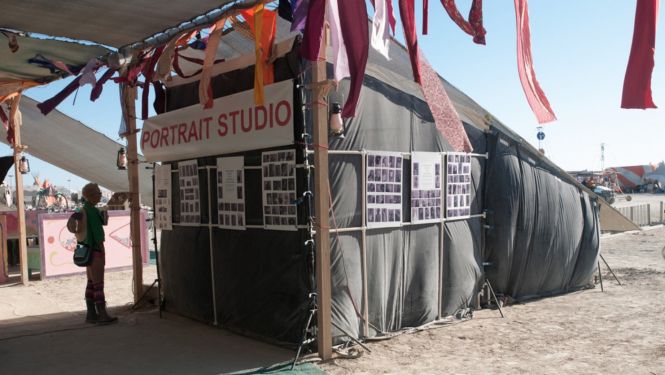by Nick “Wolfeye” King
I first learned about Burning Man in 2006 from a series of articles in the New York Times — not long before my artist wife, Ilene Kouzel, died from ALS. I showed her the articles and asked her to consider going the following year. I was hoping to give her a reason to “stick around” a while longer. She told me, “I want to leave with the first snow, but you be sure to go next year.” She was right—on both counts.
I approached my virgin Burn in 2007 as an adventure, going somewhere I hadn’t been. I was unsure about experiencing the precarious environment described by the Survival Guide and being surrounded by 35,000 people I didn’t know. The Greeters’ “Welcome home!” surprised and reassured me. More importantly, after a couple of days on the playa, I felt like I was home despite (or perhaps because of) the overwhelming cacophony of sounds and sights.
It was three days before I discovered David Best’s towering Temple of Forgiveness. Fortunately, I had a photograph of Ilene that I was able to tape to the Temple and space to add some words of remembrance. The sacredness with which Burners treated the Temple, the writings and memorabilia moved me enormously.
 When the Temple burned on Sunday night, I alternated between tears of grief and joy, and taking photographs of the burn. I am a photographer, after all.
When the Temple burned on Sunday night, I alternated between tears of grief and joy, and taking photographs of the burn. I am a photographer, after all.
In those moments, I vowed to do something to help support the construction of future Temples, but I wasn’t sure how.
The next year, as I explored the Burn with an eye to what I could do, I came up with the idea to make a book focused more on Burners than the art and activities of the event. I recalled Irving Penn’ book, Worlds in a Small Room, and the way he traveled the world with a portable tent as a temporary studio. I pitched the idea to Andie Grace, then the Communications Manager for Burning Man. She put me in touch with Jonsey Jones, who was in charge of the Center Camp Café at the time. By 2009’s Burn, I had created and set up my own portable studio at Center Camp.
The Burners’ response to the project and the studio during the week was wonderful and almost overwhelming. I worked from 10 am until the light faded around 6 pm. I photographed nearly 200 people. My subjects ranged from babies to folks in their late eighties. The energy in the studio was amazing and magical. Some Burners stayed for two hours or more to watch, encourage, and feel the connections being made. More often than not, Burners opened their hearts and souls to me, as I did to them, as we danced together in the studio. They allowed me to see and record the authenticity of the collaboration we co-created.
I believe the resulting portraits often reveal aspects of their souls or character that may not have been seen before. Mostly, I felt a soul level connection with my collaborators and was nourished by the experience. I think that is why I was able to be so completely absorbed in the experience that nothing else mattered but the connection we were creating. It is also why — despite being in my early seventies — I had the energy to be with so many Burners non-stop.
For three months, following each Burn, I sent high-resolution images out to all of the participants for their personal use. Well, at least all of the participants whose email addresses I could accurately read on their model release cards.
Soon after I began making the portraits in 2009, I realized that the project was about more than honoring my late wife or even helping fund future Temples. This project is about revealing to the world the diversity, generosity, openness and range of emotions Burners bring to — and experience at — Burning Man’s celebration of the human spirit, creativity, and freedom.
If you are interested in learning more about the book project, please go to my Indiegogo campaign. I am trying to raise as much money as I can to fund future Temples. Each perk is identified by a Temple name, and some include the ability to have a hand-bound book with a portrait of your choice on the cover. These, in particular, will become unique collectors’ items in the future.

